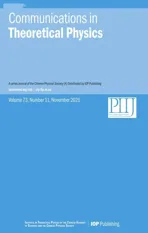Impurity effects of the Λ hyperon in the hypernuclear systems Mg and Si
2021-11-13JiWeiCuiandXianRongZhou
Ji-Wei Cui and Xian-Rong Zhou
1 School of Physics and Optoelectronic Engineering,Xidian University,Xi’an 710071,China
2 Department of Physics,East China Normal University,Shanghai 200241,China
Abstract Based on the beyond-mean-field Skyrme–Hartree–Fock model,impurity effects of the Λ hyperon in the hypernuclear systemsMg andSi are investigated,respectively.Four cases,in which the Λ hyperon occupies the single-particle orbitalsare focused.In each case,the potential energy surface and the energy curves projected on certain angular momenta are employed to show the influence of the Λ hyperon on the nuclear core.Beside the shrinkage effect that is induced by the Λ hyperon occupying the sΛ orbital,it is found that the Λ hyperon on the pΛ orbital,drives the nuclear core toward a prolate shape,while the ones on the other two pΛ orbitals, and,drive the nuclear core toward an oblate shape.The energy spectra and the corresponding intra-band E2 transition rates for the rotational bands are given as a prediction for future experiments.
Keywords: Λ hypernuclei,Skyrme–Hartree–Fock model,angular momentum projection,generator coordinate method
1.Introduction
In the past several decades,experimental technologies for Λ hypernuclear systems have been well developed [1–3].By(K-,π-) and (π+,K+) reactions,excited energy levels corresponding to various hypernuclear configurations were obtained [1–3].Most of hypernuclear configurations are constructed by a nuclear core coupled with a Λ hyperon occupying the sΛor pΛorbital,and these configurations lead to various impurity effects.However,high-resolution energy levels for the pΛ-orbital hyperon are rare except that the ones for the configuration [12C⊗Λp] were observed [4,5].In recent years,due to the (e,e′K+) reaction [6] and the Ge detector array(Hyperball)[7,8],high qualitative information on Λ hypernuclear structure is available and these provide a good opportunity to precisely study the transitions that involve the Λ hyperon exited onto the pΛorbital.For the observed light hypernuclei lighter thanC,most of the pΛstates are unbound.Therefore,it is needed to study the impurity effects of the pΛhyperon in heavier systems.The hypernuclear systems with a nuclear core in sd-shell region become good choices.There are also experimental plans for medium and heavy Λ hypernuclei [9].
On the other hand,theoretical studies about Λ hypernuclei also achieve great progress.For light Λ hypernuclei,the shell model [10–13] and the microscopic cluster model[14–17] are the most promising ones that can give very precise predictions for the energy spectra and transition rates.And recently,the ab initio calculation has also been extended to the hypernuclear regime[18].However,for the hypernuclei beyond the p-shell mass region,those three kinds of models are bothered by the rapidly increasing computational burden.For sd-shell Λ hypernuclei,the antisymmetrized molecular dynamics(AMD)seems to be a suitable model that gives very detailed predictions about the energy spectra and E2 transitions [19–22],which is waiting for the testification of experimental observations in future.
Among all the existing theoretical models,only the mean-field models,i.e.the Skyrme–Hartree–Fock (SHF)model [23–31] and the relativistic mean-field (RMF) model[32–37],are able to study all the hypernuclei from light ones to heavy ones,with an acceptable computational burden.And furthermore,the mean-field calculations treat the nucleons and the Λ hyperon on equal footing.In the last 5 years,beyond SHF [38–41] calculations and beyond RMF [42–44]calculations are,respectively,implemented to study the Λ hypernuclear systems.In these beyond-mean-field calculations,the angular momentum projection (AMP) techniques give the rotational energy levels,and the generator coordinate method takes the configuration-mixing effect into consideration.Based on the mean-field calculations,five-dimensional collective Hamiltonian model (5DCH) [45,46] and the particle-rotor model [47–49] are also used to investigate the energy spectra or impurity effects of the Λ hypernuclei,although the two models are not totally microscopic.
In the sd-shell mass region,24Mg and28Si are two typical nuclei that are prolately deformed and oblately deformed,respectively,which are testified by the observed static quadrupole moments[50].Therefore,contrastive investigations ofMg andSi are helpful to clarify the impurity effects of the Λ hyperon that occupies the sΛor pΛorbital.In this paper,the beyond SHF model is employed to give the energy spectra and intra-band E2 transitions ofMg andSi.On one hand,the energy spectra and E2 transitions give reliable clues about the impurity effects;and on the other hand,the theoretical predictions in this paper will shed some light on the future experiments.
This paper is organized as follows.In section 2,the formalism of the beyond-mean-field calculation is introduced.Section 3 presents the results and discussions.Finally,a conclusion is given in section 4.
2.Model and method
In the SHF model,the energy density functional(EDF)of the Λ hypernuclear system is given as [30]

whererepresents the Skyrme-type NN interaction for the nuclear core andεΛaccounts for the Skyrme-typeNΛ interaction.The last term,is for the hyperonic spin–orbit interaction that is always neglected in the former researches for its smallness,but kept in this current calculation as [29,51]

Single-particle states are obtained by the variation of the EDF.It must be emphasized that an additional quadrupole constraint is included in the variational procedure,which ensures the axiality of the whole system.The variational procedure is a selfconsistent one,and in each iteration,the pairing force between nucleons are included.It takes the form of a density-dependent delta interaction [52]

where ρ0is the saturation density and V0is the strength of the pairing force.The BCS method is employed to deal with the pairing force.
The wave function of the Λ hypernuclear system in the body-fixed frame of reference is given in the form of a direct product as

where∣ ΦN(β)〉 and ∣ΦΛ〉are intrinsic wave functions of the nuclear core with quadrupole deformation β and the Λ hyperon,respectively.
In the lab-fixed frame of reference,the eigen state of a Λ hypernuclear system is represented by a superposition of different configurations

where the deformation parameter,β,plays the role of generator coordinate,and the AMP operator,restores the rotational symmetry.The third component of angular momentum in the body-fixed frame of reference,K,is a sum of two parts

in which KcandΛKare for the nuclear core and the Λ hyperon,respectively.With the assumption of time-reversal symmetry for the nuclear core,Kc= 0 and K is totally determined byΛK.
The weight functionin equation(5)and the eigen energies are determined by the Hill–Wheeler–Griffin equation[53]

where the Hamiltonian and norm elements are given by


where the last two terms on the right-hand side account for the fact that the projected wave function does not provide the correct number of particles on average [54–56] andis determined by the EDF in equation (1).
The reduced E2 transition rate is derived as

where

Notations: In this paper,single-particle orbitals of the Λ hyperon are denoted by the Nilsson quantum numbers[Nn3ml]Ωπ,and the same notation is also adopted in [36].Then,a certain configuration of the Λ hypernuclear system is given asA-1Z ⊗Λ[Nn3ml] Ωπ,in whichA-1Zis the nuclear core and Λ[Nn3ml] Ωπrepresents a Λ hyperon occupying the orbital [Nn3ml]Ωπ.
Parameters:In the current calculation,the SLy4[58]and SLL4[31]parameters are adopted for the NN interaction and for theNΛ interaction,respectively.The strength of the pairing force is set to V0= -1000 MeV fm3for both protons and neutrons [59],and a smooth pairing energy cutoff of 5 MeV around the Fermi level is used as in [29,39].
3.Results and discussions
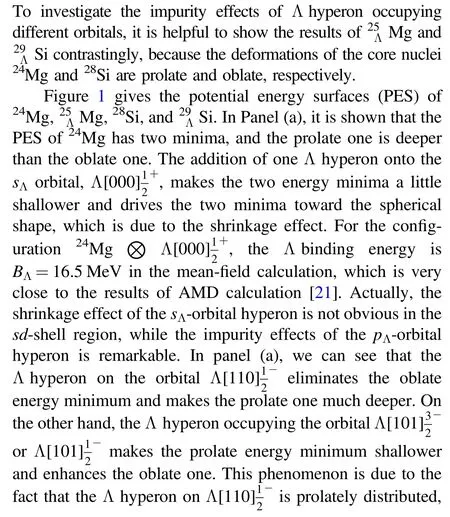

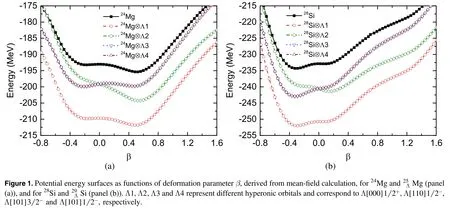
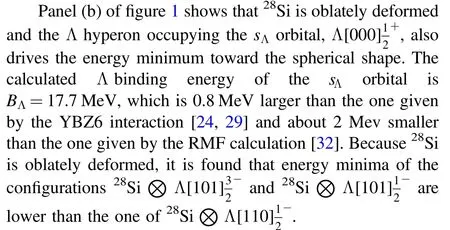
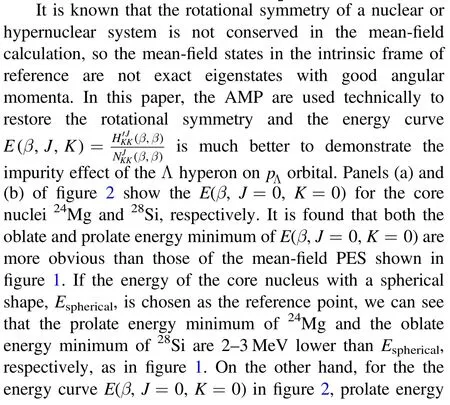

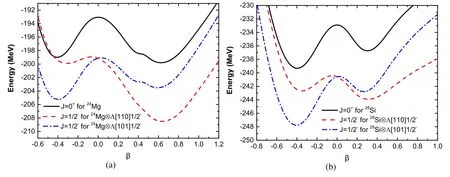
Figure 2.Energy curve E(β,J,K)for 24Mg andMg(panel(a)),and for 28Si andSi(panel(b)).The configurations and corresponding angular momenta are shown in each panel.
The comprehensive energy spectra which are composed by the rotational bands corresponding to various hypernuclear configurations are given in figures 3 and 4 forMg andSi,respectively.In each figure,the experimental and theoretical ground-state bands of the core nuclei are also shown for comparison.
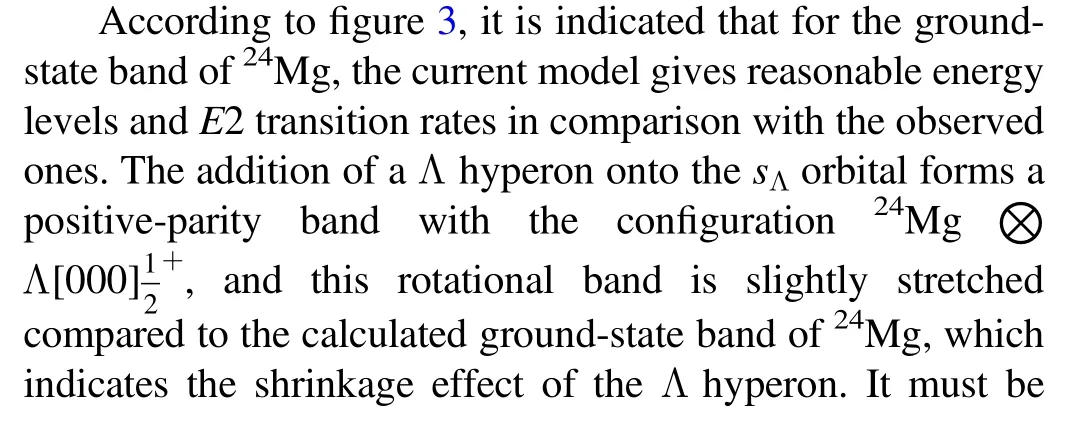

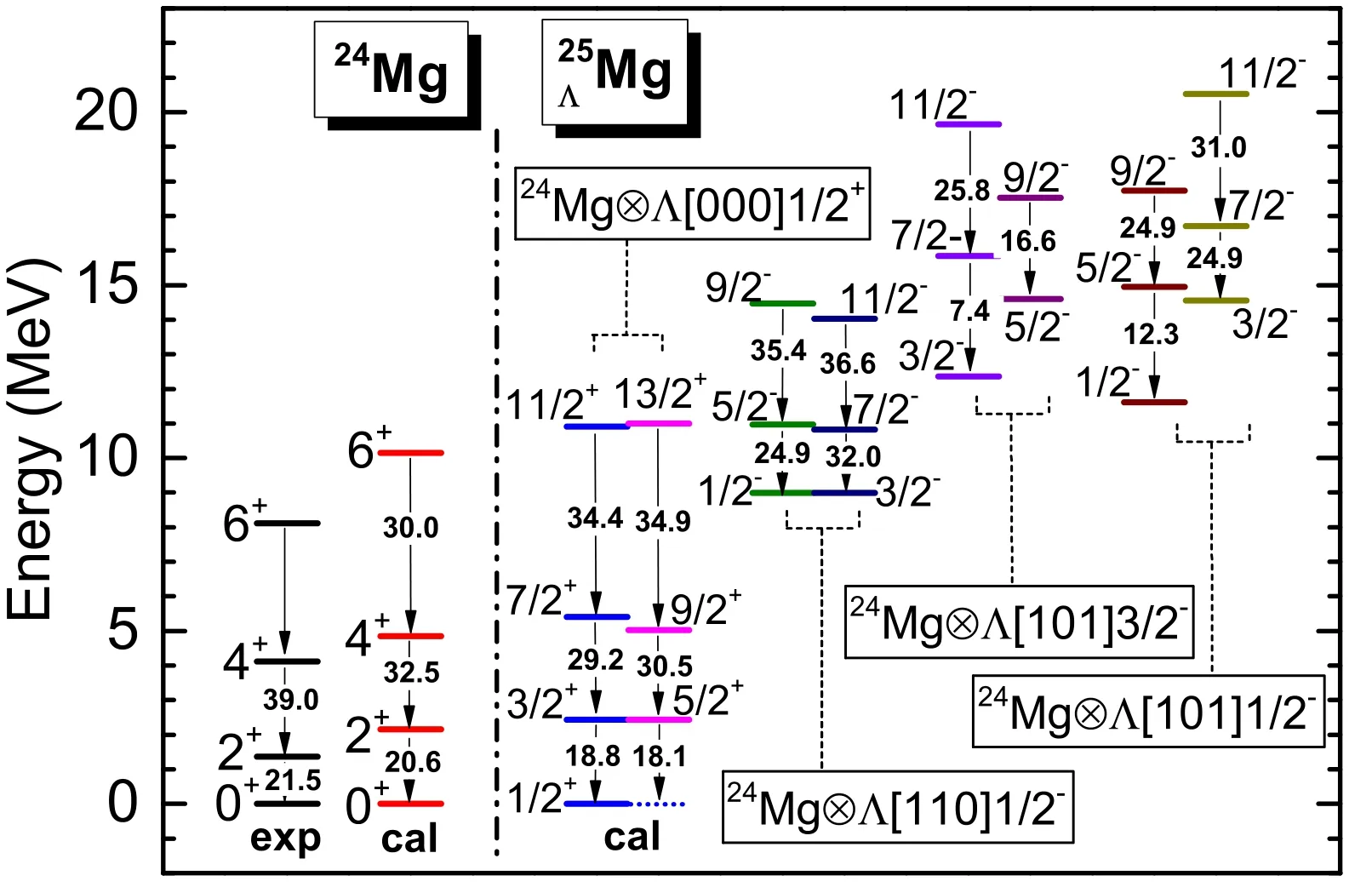
Figure 3.Energy spectra for 24Mg andMg.The observed data and calculated ones are labeled by ‘exp’ and ‘cal’,respectively.The reduced E2 transition rates are indicated by solid arrows and the configurations of the rotational bands are indicated by dashed lines.The experimental data are taken from [61] for 24Mg.
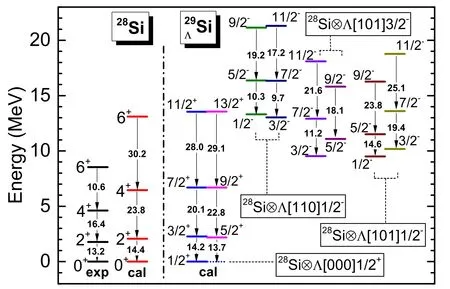
Figure 4.Same as figure 3,but for 28Si andSi.
Beside the energy bands,the intra-band E2 transition rates are also presented in figures 3 and 4 waiting for testification by future experiments.In earlier researches such as the 5DCH model [45] and the AMD model [21],E2 transition rates of nuclear cores,denoted by cB(E2),are given to show the shrinkage effect of the confgiuration24Mg⊗Λ[000The 5DCH model shows that,for the E2 transition fromstate tostate,cB(E2)is reduced by about 9%compared to B(E2)of24Mg [45],while the AMD model shows such reduction is about 6% [21].In our current work,cB(E2)is also calculated and it is reduced by about 9%,which indicates that the beyond SHF model is as reliable as the other models available on the market.
It is worth mentioning that impurity effects of the Λ hyperon on the nuclear core with octupole deformation(a pear-like shape)is very interesting.The RMF calculation has shown that,inNe,the Λs(Λp)becomes more and more concentrated around the bottom (top) of the ‘pear’ with the increase of octupole deformation[44].Mg andSi may also have nuclear cores with octupole deformations due to the clustering structure.To investigate impurity effects under such conditions,constraints on octupole moments and parity projection techniques will be introduced into the beyond SHF model in our future work.
4.Conclusions
In this paper,sd-shell Λ hypernuclei,Mg andSi,are studied by the beyond-mean-field SHF model with SLy4 and SLL4 parameter sets for NN interaction andNΛ interaction,respectively.Mean-field calculation shows that the PES of a Λ hypernuclear system is determined jointly by the orbital that the Λ hyperon occupies and the shape of nuclear core.Beside the shrinkage effect of theΛs-orbital hyperon,it is found that the Λ hyperon occupying the orbitalpulls the shape of the nuclear core toward the prolate side,while Λ hyperon on the orbitalsandmake the nuclear core more oblate.From the perspective of beyond-mean-field calculation,the current model gives the positive- and negative-parity rotational bands for various configurations separately.The impurity effects of different configurations mentioned above are also shown by the relative positions of the energy bands and the E2 transition rates,which wait for further testification by future experiments.
Acknowledgments
One of the authors thanks X Y Wu for helpful discussions.This work was supported by the National Natural Science Foundation of China (Nos.11905165,11775081 and 11547044) and the Fundamental Research Funds for the Central Universities (Nos.JB160510 and XJS18020).
杂志排行
Communications in Theoretical Physics的其它文章
- How polar hydroxyl groups affect surface hydrophobicity on model talc surfaces
- The interference between a giant atom and an internal resonator
- Optical soliton in a one-dimensional array of a metal nanoparticle-microcavity complex
- Constraint on nuclear symmetry energy imposed by f-mode oscillation of neutron stars
- Wormhole solutions and energy conditions in f(R,G) gravity
- Valley-resolved transport in zigzag graphene nanoribbon junctions
